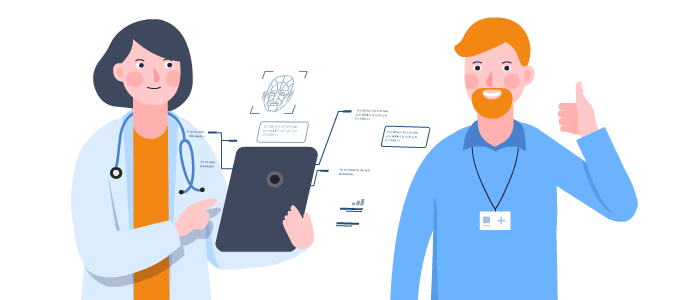How Digital Health Records Are Changing the Patient Experience

Digital health records, also called Electronic Health Records (EHRs), have changed the way patients experience healthcare. Unlike paper charts, EHRs store plenty of information. From medical history, medications to test results, and treatment plans, healthcare specialists can retrieve it all digitally. The result? This instant access ensures patient safety and care quality.
EHRs are used all over the world. In the United States, over 90% of hospitals have adopted these systems, and about 85% of healthcare providers say EHRs improve patient care. On top of that, EHRs save time. Patients also get more control. They can use portals to check records, book appointments, or message their care team without calling the office.
This guide takes a look at the main benefits, key features, and the questions people usually ask about digital health records. Bottom line, using this system can make healthcare run smoother and more reliable for both doctors and patients.
How Digital Health Records Improve Patient Experience
Below, we have highlighted the top benefits of integrating the EHR system into your client’s practice.
Reducing Errors Through Accurate Data
Handwritten notes often led to mistakes – from unclear handwriting, misplaced files, or wrong dosages. Digital health records eliminate these risks with standardized data entry. Every prescription and diagnosis are recorded clearly, so doctors don’t make mistakes from unclear notes. This helps patients get safer treatments and avoid problems caused by staff.
Faster Access To Health Information
Patients no longer need to wait for paper files to be located or transferred. Authorized doctors can instantly pull all the records, even from remote locations. In emergencies, this speed is critical. For instance, a paramedic can utilize emergency medicine EMR software to access allergy histories before administering medication.
Seamless Coordination Among Providers
Digital records let specialists, primary care doctors, and pharmacies see the same patient information. This stops duplicate tests and keeps treatments from clashing. For example, a cardiologist can review the medications a primary doctor has already prescribed. The result? Providers mitigate risks of dangerous drug interactions.
Helping Patients Take Charge of Their Health
The majority of EHRs include a patient portal, telehealth, and mobile apps. This means that patients can schedule appointments, check lab results, and get prescription refills all from the comfort of their own homes.
Some portals even remind users to get flu shots, mammograms, or blood tests. As a result, patients are able to maintain their health without overexerting themselves.
Saving Time And Cutting Costs
Paperwork used to consume a significant portion of clinic time. But features like automated scheduling, billing, and prescription management cut back administrative burdens. Now, providers can spend more time on patients instead of forms. With past records, patients can save time and cut back on added cost by not repeating the same tests.
Core Features Of Digital Health Records For Better Patient Experience
Digital health records are rich in features that make it easier for patients to receive the right kind of care. Below, we have outlined some of the key features of EHR.
Patient Demographic For Accurate Identification
Every EMR starts with demographics, including name, address, contact details, date of birth, and gender. These aren’t just formalities. In reality, this data can help providers make better decisions. This is done by ensuring that test results, prescriptions, and appointments are linked to the right patient.
For instance, even a single typo in an address or date of birth causes files to be mismatched. But digital systems can easily minimize the risk. For patients, this doesn’t only mean less administrative errors, but also smoother communication with providers.
Complete Medical History And Problem Lists
Before digital systems, a patient’s medical files were all over the place on paper. Test results that used to take days to go from one department to another now zip straight into the digital system. That means lab results, imaging scans, ECGs, and pathology reports show up in minutes so no more waiting around.
For example, if a blood test shows high glucose, the doctor gets an alert in the nick of time. They can make quick adjustments and start treatment fast instead of waiting days. The result? Patients get quicker care and a better shot at bouncing back sooner.
Laboratory And Diagnostic Test Integration
There was a time when test results took days. But now they are uploaded directly into the digital system. This allows lab results, imaging scans, ECGs, and pathology reports to appear within minutes in the system.
For example, if a patient’s blood test shows abnormal glucose levels, the physician is alerted immediately, allowing for quick adjustments in care. This helps doctors confirm the diagnosis quickly and start treatment without any waiting days. For patients, this means faster care and better recovery chances.
Medication Management For Safety
Healthcare professionals shouldn’t take medication errors lightly. Because EHRs actively track each prescription medication, its dosage, and any possible interactions, they can effectively prevent catastrophic errors.
Let’s say, a doctor tries to prescribe a drug that might interfere with one that already exists in the patient’s system. The system then instantly sends out an alert. This, in turn, benefits the patient from lower duplicate prescriptions, fewer risky drug mix-ups, and safer therapy.
Clinical Notes, Vitals, And Treatment Plans
Healthcare providers no longer need to rely on separate handwritten charts. These tools let doctors keep everything in one place. From clinical notes to treatment plans, everything can be accessed in one spot. This particularly comes in handy when a patient sees several specialists.
For instance, two specialists – such as an oncologist and a cardiologist – can check out the latest notes before making the final call. With this, they can avoid treatment mix-ups. In this way, patients receive coordinated, safer care that adheres to the best medical standards.
FAQs
What is a digital health record system?
A digital record system, or EHR, is a secure system that stores a person’s health history. It records medical appointments, therapies, prescription drugs, and other health-related data. Patient information is kept strictly private because only authorized healthcare professionals can see it.
What kind of patient information is in the digital system?
EHRs store numerous data such as hospital stays, lab results, test reports, discharge summaries, medications, allergies, vaccinations, and more. It’s all in one place, so doctors can quickly find what they need.
How do EHRs make patient records more accurate?
These systems keep all the records complete, clear, and easy to read. They prevent mistakes from messy handwriting or lost papers. This helps doctors make quick decisions without any confusion.
Can these tools help different doctors work together?
Yes. EHRs let specialists, labs, and primary care doctors share information easily. Everyone sees the same updates which further improve collaboration among different providers.
How do EHRs help clinics follow healthcare rules?
EHRs do a lot of paperwork automatically. They make billing codes, check records, and create reports. This helps clinics follow rules like health insurance portability and accountability act (HIPAA), meet quality standards, and stay certified.





While the efficiency of EHRs is impressive, I think it’s also important to note how it can empower patients to take charge of their health. With portals offering easy access to records and communication with healthcare teams, it feels like healthcare is becoming much more patient-centered.